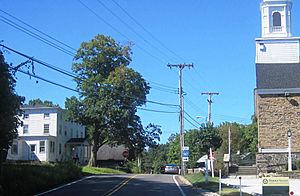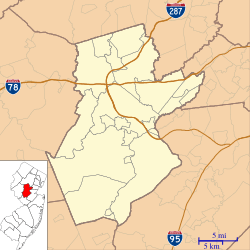Neshanic, New Jersey facts for kids
Quick facts for kids
Neshanic, New Jersey
|
|
|---|---|

Neshanic along Amwell Road (CR 514)
|
|
| Country | |
| State | |
| County | Somerset |
| Township | Hillsborough |
| Area | |
| • Total | 3.60 sq mi (9.33 km2) |
| • Land | 3.57 sq mi (9.25 km2) |
| • Water | 0.03 sq mi (0.09 km2) |
| Population
(2020)
|
|
| • Total | 854 |
| • Density | 239.22/sq mi (92.37/km2) |
| Time zone | UTC−05:00 (Eastern (EST)) |
| • Summer (DST) | UTC−04:00 (Eastern (EDT)) |
| FIPS code | 34-50040 |
Neshanic is an unincorporated community and census-designated place (CDP) located within Hillsborough Township, in Somerset County, in the U.S. state of New Jersey. It is located near the South Branch Raritan River. The Neshanic Historic District was listed on the National Register of Historic Places in 1979.
History
The name comes from a tribe of the Raritan tribe of Lenape Native Americans who lived along the river. Community life for the Dutch farmers who settled there began around 1750 and centered on a church, a school, a grist mill and a tavern owned by John Bennett, which historians say was most instrumental in forming the village. The first mill was built by Bergen Huff around 1770 and there was also a tannery which supplied leather to the people of the village as well as to the nearby town of New Brunswick. At one time the area surrounding the Shirk farm and extending along the Sourland Mountains was the largest peach producing region in the State.
Historic district
The Neshanic Historic District is a historic district encompassing the village. It was added to the National Register of Historic Places on August 1, 1979 for its significance in settlement and religion. It includes 23 contributing buildings.
Demographics
As of the 2020 United States census, the population was 854.
| Historical population | |||
|---|---|---|---|
| Census | Pop. | %± | |
| 2020 | 854 | — | |
| U.S. Decennial Census 2020 |
|||
Points of interest
Nearby Neshanic Mills was added to the NRHP in 1978. The original Mill was built in 1810 and the later rebuilt by Andrew Lane in 1876. It is also known as the Amerman Mill. It operated until the late 1940s and is now a private residence.





